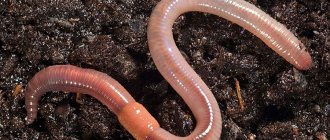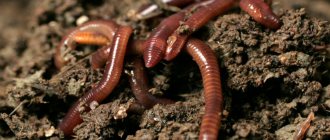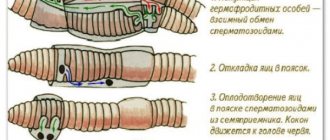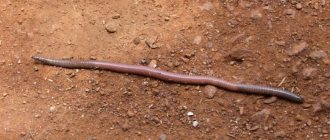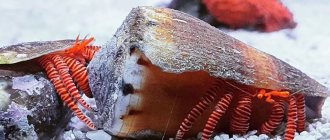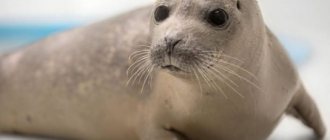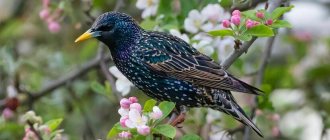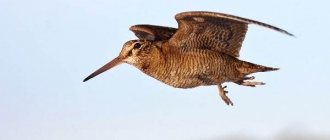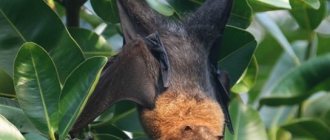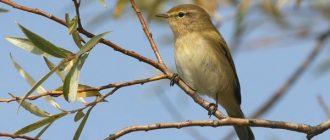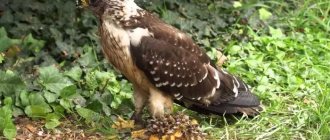Nereis are polychaete worms belonging to the Nereid family, which received their name from Greek mythology.
There is a myth that the god Nereus married the daughter of Oceanus, Doris, who gave birth to 50 Nereids - sea nymphs with a cheerful disposition. These nymphs were always next to the god of the sea, Neptune, and amused him with their dances and games.
Nereis.
Most likely, Nereis got their name for their beauty, since their bodies have a bright green color that shimmers with rainbow colors, like a gasoline film in water. The green body is bordered by red or bright orange bristles.
general information
Nereis
Nereis are polychaete worms belonging to the Nereid family, which received their name from Greek mythology.
There is a myth that the god Nereus married the daughter of Oceanus, Doris, who gave birth to 50 Nereids - sea nymphs with a cheerful disposition. These nymphs were always next to the god of the sea, Neptune, and amused him with their dances and games.
Most likely, Nereis got their name for their beauty, since their bodies have a bright green color that shimmers with rainbow colors, like a gasoline film in water. The green body is bordered by red or bright orange bristles.
Nereid - worm: description of appearance
Where does this species live? Nereids live at the bottom of the sea. These are not those who are called the daughters of the king of the sea in ancient Greek mythology. These are ordinary worms. The polychaete worm Nereid belongs to the annelids.
Its body consists of many rings, like the well-known earthworm. Nereid is a worm with a snake-like body structure. It has a head, metamerium (trunk), anal lobe, and lobe-like limbs. There are two pairs of eyes on the head of the Nereid. Also on the head section of the worm there are tentacles, two-segmented palps. The limbs of the nereid are strewn with many bristles (hence the appearance - polychaete), with the help of which it easily moves along the bottom of the sea at a speed good for a worm.
Metamerism - repeating, absolutely identical parts of the body. In our case these are rings. Nereid is a worm endowed with especially developed muscles. It can easily burrow into the bottom soil to hide from danger or lay eggs. The Nereid is very small, it rarely reaches four centimeters in length, its height is usually two or three centimeters. But individuals up to 90 centimeters are also found in fresh waters!
Such a “monster” can be found in the desalinated waters of Japan. It is called green nereis. The Nereid is a worm that is usually brown in color. It can shimmer in green, blue and red shades. The spectacle is truly mesmerizing to look at. This worm is beautiful and absolutely safe for humans. There is no need to be afraid that it will bite you or decide to live in your body. A Nereid lives amicably with a man, and he is of no interest to her as food.
Nereis habitat
Nereis live on the seabed, in burrows. They are eaten in large quantities by a variety of commercial fish, Kamchatka crabs and other marine animals.
Nereis are very high in calories. They are the basis of the diet of sturgeon, which is found in the Caspian Sea. They were even specially brought there for this purpose.
Several tens of thousands of Nereis were transported from the Azov Sea to the Caspian Sea in special refrigerators. Moreover, they adapted well to the new conditions and multiplied in large numbers. Today, the mass of these creatures in the Caspian Sea reaches millions of tons. As a result, Caspian sturgeons almost completely switched to feeding on Nereis.
The character and lifestyle of Nereis
Nereis can live in burrows on the seabed, but more often the worms simply bury themselves in the mud. Often, while walking and searching for food, they swim above the surface of the bottom. They can be called homebodies because they do not move long distances before the breeding season.
Recently, scientists discovered a rather unusual feature of Nereis, unusual for worms. They communicate with each other in a language only they understand. This happens with the help of chemicals that they release into the environment. They are produced by skin glands located on the body of polychaetes.
These substances are pheromones. They have different purposes: some attract females, others scare away enemies, and others serve as a warning of danger to other worms. Their Nereis are read using sensitive organs that are located on the head. If they are removed, this will lead to the death of the worm. He will not be able to find food for himself and will easily become prey to the enemy. Several species of Nereis behave like spiders when hunting. They weave nets from special mucous threads. With the help of which they catch sea crustaceans. By moving, the net lets its owner know that it has caught prey.
Search and methods of extraction
Nereis is not easy to get. The sea worm is searched for in estuaries, estuaries of rivers flowing into seas or salty estuaries, and in silt deposits. Soil from the bottom is scooped up with shovels and laid out on the shore, or on special tables, which are taken into the water if the depth allows. The dirt is sorted out, washed away with water, and Nereis is selected. Store it in jars with wet seaweed or with the soil in which it was found. It is difficult to find sea worms in stores. It dies 1.5-2 days after being removed from its natural habitat.
But local residents living near the habitats of Nereis dig it for sale. On the way to estuaries or seas to catch mullet and mullet, you can often find advertisements for its sale.
When can you catch pelengas?
Pelengas are actively caught in the morning, although they can be caught no less actively both during the day and in the evening. At the same time, pelengas begin to peck from mid-May and this period continues until late autumn.
Interesting materials:
Can asphalt be recycled? Is it possible to replant raspberries in summer? Is it possible to replant a rose in October? Is it possible to replant flowers on the waning Moon? Is it possible to transfer from one university to another with a Grant? Is it possible to swim on air mattresses? Can a dog owner be sued? Is it possible to connect the vacuum cleaner motor directly? Is it possible to go to tourism after 9th grade? Is it possible to study to become a surgeon after 9th grade?
Nereis storage
Of course, for an angler who wants to catch mullet, it will be much easier and cheaper to buy this unusual bait, since about a hundred worms will be enough for fishing (of course, everything will depend on how the bite is). The cost of purchasing a worm will be much lower than if you refuel a car for a trip, and besides, as already mentioned, this process is really complicated, and labor also costs money.
If, nevertheless, you had to dig the worm yourself, then you have to save it for several days, or even weeks, since if the worm disappears, you will feel sorry not for the worm itself, but for the efforts made to get it.
Experienced fishermen know how to preserve the Nereis (estuary worm) for some time, but in most cases these methods take a lot of time, since you have to monitor the worms every day, which is sometimes simply impossible.
Ways to save a worm
These methods are radically different from those that are generally considered “adequate”. The whole point is that the worm does not need to be kept alive, but just to “drive” the moisture out of it, which means killing it.
Yes, everyone will say that they only bite on a live worm, etc., but a live “watery” worm, when cast with force, breaks into the water, and, if you’re lucky, a small piece remains on the hook. The worm preserved using these methods has a completely different viscosity and does not fly off the hook, allowing you to catch several fish with one worm.
- The first method does not cause any difficulties and does not require explanation; all you need is to pour vodka or alcohol into the worm and put it in the freezer. The advantages of this method are that the worm adds its own volume, thus becoming like edible silicone.
- The second method is to salt and dry the worm. To do this, you need to generously cover the washed worm with salt, let it stand in a sieve for about 40 minutes, and then pour it onto a flat, inclined surface. Then it should be spread over the entire area, so that it can dry for about 2 hours. The advantages of this method are that the worm looks more reliable and becomes fleshy, since the salt has drawn out the moisture almost completely.
On a hook, a worm preserved in this way looks much more appetizing. The number of bites, which is the most important thing in the life of every fisherman, on such a worm is no less than on a live one, and if a live worm is baited with ordinary hooks, it will be better to catch a “drunk” or salted worm, since it is more stable .
Nereis - sea worm
People have always disliked everything slippery and wiggling. And if it is found under thick water and can attack at the most inopportune moment... Brrr! Fear and wild imagination endowed sea monsters with colossal size and excessive cruelty. Ancient illustrations often depicted ugly monsters who wanted the death of brave sailors.
Alexander Semenov
In fact, it often turned out that the “monsters” themselves were terribly afraid of everything, and their sizes were simply ridiculous. Perhaps this is how ordinary iguanas “turned” into terrible dragons. Or maybe the ancient Chinese were inspired by Nereis (lat. Nereis) - colorful polychaete worms from the Nereid family? But it’s true - if you look at these quite peaceful worms a little more closely, you can find a number of similarities with the Chinese dragon: long whiskers, strange spikes on the back, a light belly and a bright, textured pattern on the body.
Alexander Semenov
Where could the Chinese see them? Yes, many places. Nereis are found in the warm seas of Southeast Asia and live in the Sea of Japan and the White Sea. In addition, they exist in both the Black and Azov Seas. It was from there that in the early 40s of the last century they were moved to the Caspian Sea to please the local species of valuable sturgeon. Nereis quickly took root and multiplied in a new place and provided food not only for fish, but also for gulls, terns and other lovers of sea life.
Alexander Semenov
Nereis lead a bottom-dwelling lifestyle almost their entire life. They feed on plants, rotting remains of algae, eat the corpses of mollusks and crustaceans, and sometimes become predators. Interestingly, these primitive-looking worms have their own language for communication: they release special chemicals (pheromones) into the water with various odors that attract individuals of the opposite sex, signal danger or scare away enemies. Nereis catch them with the help of special supersensitive organs, upon removal of which the worm becomes absolutely helpless.
Alexander Semenov
Puberty dramatically changes the appearance of Nereis. It is then that they become similar to Chinese dragons: their eyes enlarge, the bristles on the body become wide and flat, the body segments expand, and the number of muscles responsible for motor activity increases significantly. Such individuals get the opportunity to swim, which they immediately take advantage of.
Alexander Semenov
Hundreds and thousands of Nereis rush to the surface of the water to find a partner. By that time, their size is already quite noticeable (some species grow up to 60-70 cm in length). And they all squirm, wriggle and twist in order to attract the attention of individuals of the opposite sex. Of course, this is immediately noticed by seabirds and fish, who do not miss the opportunity to eat to their fullest. It’s funny that fishing at this time is absolutely useless, since a fish that has eaten 40-gram worms simply won’t look at your pathetic bait.
Alexander Semenov
The process of reproduction in Nereis is quite original: eggs and “milt” are swept directly into the water through breaks in the walls of the body. After which the worms sink to the bottom, burrow into the soil and die within a week. That is, adults can produce offspring only once in their lives.
Alexander Semenov
However, there is one species of Nereis whose method of reproduction is even more unusual. The fact is that all their young worms are male. When they become sexually mature, they swim to the burrow of the nearest female, unceremoniously fertilize all the eggs she has laid, and then devour the unfortunate one. After which they become exemplary fathers: they take care of the clutch, protect it and regularly “ventilate” the mink.
Alexander Semenov
And yet you have to answer for bad deeds. It turns out that this rule also applies to worms. After a while, the male turns into a female, lays eggs and patiently waits for his own tempter-destroyer.
Nereis on a hook
This worm is attached to a hook (usually No. 7) in different ways: for catching small fish - one piece at a time, for large ones - whole, pulled onto the fore-end from the head - with a “stocking”, or several pieces at once, pierced in the middle.
This worm is very soft and when pressed hard with a finger, it crawls apart. To facilitate the process of placing Nereis on a hook, there is a simple device - a thin metal tube, hollow inside. The worm is first placed on this tube, then the hook is inserted into the hole of the tube and the worm is carefully pulled from the tube onto the hook. With this method, this delicate worm often remains intact and looks more lifelike on the hook. When catching large fish, the worm is put entirely on the hook and part of the leash.
The only drawback of sea worms, perhaps, can only be considered that they have a weak hold on the hook and if there is any, even a small force, they can fall apart, but otherwise this is perhaps one of the best baits for fishing at sea.
Reproduction of Nereis
Nereis begin mass reproduction when the water temperature rises, and the time of the mating season can be tied to the phases of the lunar cycle. Sea worms react to moonlight and swim to the surface of the water. If the water is artificially illuminated using a spotlight, this can cause a mass emergence of sea worms. Scientists use this feature of Nereis to lure rare species that are difficult to catch because they lead a bottom-dwelling lifestyle.
The meaning of the transformation of Nereis during the breeding season is quite logical. When sea worms begin to swim, the chance of sex meeting and fertilization increases. Otherwise, it would be difficult for inactive Nereis to find a mate. In addition, active movement during the mating season contributes to the spread of the species. These worms developed a reaction to moonlight and high temperature precisely in order for their mass swarming to take place.
Trochophores hatch from fertilized eggs. Their bodies are ringed with 4 ciliary rings. In appearance, trochophores are similar to insect larvae. On the posterior edge of the head lobe they have not too long bristles, and on the sides of the body there are 3 lobes, from which extend long tufts of segmented bristles, which resemble fingers with long claws. Trochophores can obtain food on their own; they grow very quickly.
The young settle to the bottom, dig holes, and life continues again. In certain species of sea worms, larvae develop inside the egg, and young nereids immediately hatch from them. This progressive property contributes to a significant increase in the survival rate of offspring, since free-swimming trochophores are attacked by a large number of predators.
Caspian Nereis, as already noted, are the main source of food for valuable sturgeon fish that need protection and be listed in the Red Book.
